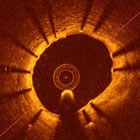|
Signal of Early Healing of Drug-Eluting Stent Seen in Resolute Onyx 1-Month OCT Study
|
 |

Optical Coherence Tomography (OCT) of coronary artery with stent |
May 24, 2018 -- The intravascular imaging modality of Optical Coherence Tomography (OCT) was introduced to the field of cardiology a decade ago. Since then it has been used to look inside the coronary artery: in order to correctly size vessel diameter for stent placement, to assess whether a stent has been expanded optimally against the vessel wall (if not, a balloon can be used to post-dilate the stent), and also to measure the extent and timing of post-stent vessel healing, specifically how quickly and completely the struts of the stent get covered over by tissue growth. It is thought that the more complete the stent coverage, the lower the risk of stent thrombosis, allowing for shorter duration of Dual AntiPlatelet Therapy (DAPT).
The first generation of Drug-Eluting Stents (DES) necessitated 12 months of DAPT in the U.S. (although European guidelines were only for six months). More recently, with the advent of newer, thinner strut DES, the hope has been that DAPT duration could be shortened safely . Analysis of various clinical trials and registries studying the new generation DES have provided data to reassure cardiologists that in lower risk patients, shorter durations of three and six months may be acceptable.
Notably, five years ago and based on the 5,000 patient Resolute clinical program, the Conformité Européenne determined that patients implanted with Medtronic's Resolute Integrity DES (the precursor to the Onyx) who had to discontinue DAPT at only one month were "at low risk and showed no increased risk for stent thrombosis."

CoreWire Technology: dense inner core, wrapped in cobalt alloy outer layer; entire stent is molded from a single strand of wire |
The newest DES in the Resolute brand is the Onyx, approved by the FDA a year ago. Like the Integrity, the Resolute Onyx zotarolimus-eluting stent utilizes Medtronic's proprietary Continuous Sinusoid Technology, wherein the stent is fashioned from a single strand of cobalt alloy wire. Added to this structural design is CoreWire Technology, a dense inner core which allows much clearer visualization under fluoroscopy and greater radial strength, allowing the stent strut thickness to be reduced as well. The intent was to promote easier, more reliable placement, and rapid healing of the endothelium, the inner lining of the artery
To test this concept with direct visualization, a small group of 15 patients had OCT imaging performed at one month (13 of them diagnosed with acute coronary syndrome or ACS). The results were presented this week at the annual EuroPCR meeting in Paris, and they were as hoped for. At only one month, an average of 88% of the struts were covered by neointimal formation (new cell growth over the struts) with 92.3% of the total stented area showing complete coverage.
These data and results should reassure clinicians that, if a patient who has had an Onyx implanted needs to discontinue or interrupt DAPT at one month, due to unplanned surgery or adverse reactions to the antiplatelet therapy, the risk of stent thrombosis is very low.
Today's press release from Medtronic appears below, also with information about an additional EuroPCR presentation of data from the DAPT-STEMI study.

Independent Stent Imaging Study Shows Excellent Healing Profile with Resolute Onyx DES in Complex Patients with Coronary Artery Disease
Onyx 1-Month OCT Study Provides Potential Insights on DAPT Duration in Complex Patients Following Stent Implantation
May 24, 2018 -- Dublin and Paris -- Investigators today unveiled clinical data from the independently run Onyx 1-Month OCT Study, which showed strong early vessel healing in a patient population that contained a high percentage of patients with complex coronary artery disease who were implanted with the Resolute Onyx™ DES at one-month follow-up. Presented at the EuroPCR Annual Meeting in Paris, data from 15 patients - including 13 with acute coronary syndrome (ACS) - were evaluated using Optical Coherence Tomography (OCT), a light-based intracoronary imaging that provides extremely high-quality images of the coronary wall, especially of the structures closest to the vessel lumen.
In the Onyx 1-Month OCT Study, patients implanted with the Resolute Onyx DES demonstrated an excellent early healing profile with an average of 88 percent of struts covered by neointimal formation (new cell growth over stent struts) and 92.3 percent of the total stented area showing complete strut coverage at one month, which includes the covered areas in between the struts.
"The signal of early healing is crucial for patients who may need to interrupt or discontinue dual anti-platelet therapy (DAPT) within a short period of time after receiving a stent," said Elvin Kedhi, M.D., Ph.D., interventional cardiologist at Isala Hartcentrum in Zwolle, the Netherlands, one of the lead principal investigators of the Onyx 1-Month OCT Study. "These data help expand the growing body of clinical evidence that may support physicians in tailoring DAPT regimens for complex patients."
The Onyx 1-Month OCT Study is the latest of several Medtronic funded studies helping to generate additional clinical evidence to reinforce the understanding of healing and shorter DAPT regimens in complex patients. Last year, Medtronic announced the Onyx ONE Global Study, a randomized clinical trial that will compare one-month DAPT between two DES for the first time, which is currently enrolling. A similar study will launch in the U.S. and Japan later this calendar year and will help inform DAPT guidelines for newer-generation DES that currently favor bare-metal stents (BMS) for patients at an increased risk of bleeding who might require a shorter DAPT regimen.
In a separate analysis presented at the EuroPCR meeting, new data from the DAPT-STEMI trial in patients treated with the Resolute Integrity DES, showed excellent results in a prospective prespecified registry which evaluated all patients after six months of DAPT duration, prior to randomization. At six months, the patient oriented composite primary endpoint (all-cause mortality, any myocardial infarction (MI), any revascularization, stroke and TIMI major bleeding (net NACCE)) occurred in 4.2 percent of patients, with low rates of target lesion revascularization (1.1 percent) and stent thrombosis (0.7 percent).
"We are committed to generating meaningful clinical evidence to help inform physician decision making and guidelines around the use of newer-generation DES in complex patients," said, Dave Moeller, vice president and general manager of the Coronary and Renal Denervation business, which is part of the Cardiac and Vascular Group at Medtronic. "These results reinforce our commitment to studying one-month DAPT in studies like the Global Onyx ONE Study which is currently enrolling around the world."
The Resolute Onyx DES with thinner struts is the first and only DES to feature Core Wire Technology, an evolution of Continuous Sinusoid Technology (CST). CST is a unique Medtronic method of stent manufacturing, which involves forming a single strand of cobalt alloy wire into a sinusoidal wave to construct a stent. This enables greater deliverability and conformability to the vessel wall. With Core Wire Technology, a radiopaque inner core is incorporated within the cobalt alloy wire to enhance visibility for accurate stent placement. Core Wire Technology also enables thinner struts while maintaining structural strength.
The Resolute Onyx DES received CE (Conformité Européene) Mark in September 2014 and FDA approval in April 2017.
In collaboration with leading clinicians, researchers and scientists worldwide, Medtronic offers the broadest range of innovative medical technology for the interventional and surgical treatment of cardiovascular disease and cardiac arrhythmias. The company strives to offer products and services that deliver clinical and economic value to healthcare consumers and providers around the world.
About Medtronic
Medtronic plc (www.medtronic.com), headquartered in Dublin, Ireland, is among the world's largest medical technology, services and solutions companies - alleviating pain, restoring health and extending life for millions of people around the world. Medtronic employs more than 84,000 people worldwide, serving physicians, hospitals and patients in more than 160 countries. The company is focused on collaborating with stakeholders around the world to take healthcare Further, Together.
Any forward-looking statements are subject to risks and uncertainties such as those described in Medtronic's periodic reports on file with the Securities and Exchange Commission. Actual results may differ materially from anticipated results.
Reported by Burt Cohen, May 24, 2018
|


